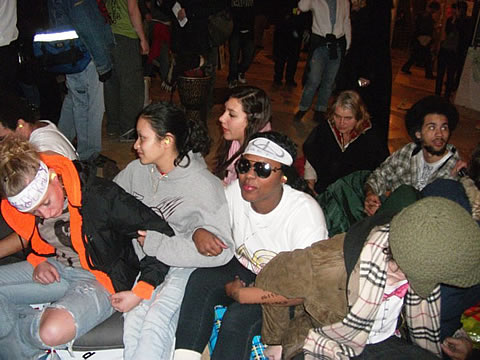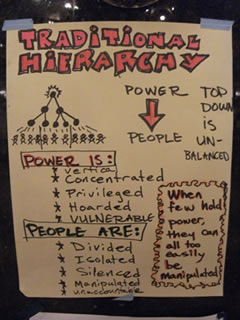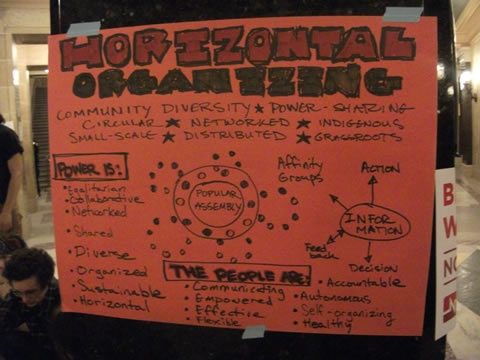Posted March 4, 2011
After police, Union reps and Democrats convinced the 50 or so people remaining in the Capitol to end their occupation last night, the most highly visible and sustained direct action against the Walker/Fitzgerald/Koch regime came to an end. As it turned out, those occupying the Capitol since February 14 were there with the tacit consent of the Department of Administration and the Capitol Police. Until Judge Albert’s decision came down yesterday, not a single order was issued to remove people from the building. Those who left did so of their own free will.

The “no arrest” policy was confirmed today by Mike Huebsch, Secretary of the Department of Administration, in a joint press conference with Capitol Police Chief Tubbs. When asked why the Department of Administration did not move to evict protesters before yesterday, Huebsch replied that “the organic expansion of people, organization and settlement” took them by surprise, as did “the spontaneity and size of the crowds.” Decisions about how to control the movement of such large crowds of people were complicated by the ongoing business of the Joint Finance Committee Hearing, the Assembly Democrat-sponsored, “quasi, though not officially sanctioned hearings” which lasted for several more days through the wee hours, followed by the three-day long session of the Assembly during which AB 11 was being debated. Huebsch said that the DoA respected the constitutional provision which states the the building must be open when there is business being conducted, and did not order people out of the building for that reason.
Secretary Huebsch thanked Judge Albert a number of times for the court order issued yesterday. He said it allows the DoA to require people to vacate the Capitol during non-business hours, and gives them the authority to implement a “capacity management plan” in accordance with Administrative Code 2. This plan currently involves the continued presence of a large number out-of-jurisdiction police officers, public access restricted to two doors only (either the North and South entrances, or the East and West entrances), security pat-downs, loss of electronic key access to Capitol employees until the DoA is satisfied they can “gain compliance from all employees” with rules of use, and a long list of sanctioned and unsanctioned items and behaviors allowed in various parts of the building. The plan is subject to minor changes at any moment depending upon conditions, but will not be substantially re-evaluated until all protests have come to an end.
Both Tubbs and Huebsch reiterated that their role was to “enforce the laws and protect the lives and property of people.” Their methods for doing so involve “gaining control of the building” as well as depending upon “the cooperation and deferential attitude toward law enforcement” of protesters. Huebsch highlighted his appreciation of protesters’ cooperation a number of times, saying how much he appreciated the fact that the people of Wisconsin can “disagree without being disagreeable.” In an eerie summation of the events of the past few weeks, Huebsch said, “the occupation of the Capitol was an historic event. I’m not sure we’ll see it again for some time.”
 After witnessing the intense pressure that was brought to bear upon the protesters by members of the Democratic Party, AFL-CIO and the Police to voluntarily leave the building last night, and the way in which many of them succumbed to it, it was probably for the best that the protesters left. A dozen or so understood that this was the moment to make the choice to enact the civil disobedience they had been training for over the previous two weeks precisely because there was finally an order that they could disobey. However, they realized that unless a critical mass of the group decided to do it, the action would not have been effective. Their numbers had been whittled down by the crackdown earlier in the week, and up until the court order and the announcement by Chief Tubbs that the police were going to enforce it, the protesters were simply pushing their luck. When push came to court-ordered shove, the majority decided to not be disagreeable, pick up their belongings and leave.
After witnessing the intense pressure that was brought to bear upon the protesters by members of the Democratic Party, AFL-CIO and the Police to voluntarily leave the building last night, and the way in which many of them succumbed to it, it was probably for the best that the protesters left. A dozen or so understood that this was the moment to make the choice to enact the civil disobedience they had been training for over the previous two weeks precisely because there was finally an order that they could disobey. However, they realized that unless a critical mass of the group decided to do it, the action would not have been effective. Their numbers had been whittled down by the crackdown earlier in the week, and up until the court order and the announcement by Chief Tubbs that the police were going to enforce it, the protesters were simply pushing their luck. When push came to court-ordered shove, the majority decided to not be disagreeable, pick up their belongings and leave.
The Democrats’ and Union reps’ line of attack was to tell the protesters that they were hurting “the movement” by continuing their occupation, and that they would damage the peaceful, compliant image of “the movement” by choosing to get arrested. They argued that arrests would play into the hands of Scott Walker by giving Fox News images of unruly people being dragged out of the the Capitol, and that the Capitol occupation no longer played any significant role in “the movement.” They also mentioned that the 14 Democratic Senators would not take their abandoning of the Rotunda as a lack of support.
As a way to lift their spirits, a Democratic staffer told protesters that they had achieved something that hasn’t been achieved in decades: the reinvigoration of the progressive wing of the Democratic party. She additionally explained that “all of this information we’ve been collecting from all of you is to activate you in our upcoming campaigns.”
All of this raises many difficult and personally challenging questions, the foremost among them being the nature and definition of “the movement.” It is clear the the Democratic Party and national and international Union reps have very particular ideas about this, and are attempting to direct the extremely diffuse, intense and disorganized energy of the grassroots into their programs. The largest of these programs is the mobilization to recall 8 Republican Senators. This would enable the Dems to vie for their seats in a matter of months. If successful, the Dems would hold a majority in the Senate which would serve as a check on Scott Walker’s lust for power, but wouldn’t alter the basic direction of state policy vis-a-vis funding of public sector institutions or material support for vulnerable and needy people.

Another question is our individual relationship to formal power, our needs to be perceived in a particular way, and how those two things inform our actions. Scott Walker’s use of intimidation tactics and displays of force are consciously targetted at the Wisconsin public’s deferential attitude toward law enforcement and our desire to be perceived as nice, reasonable, civil, law abiding citizens. We need to study the deeper meanings of civil disobedience and non-violent action against injustice, get over our desire to be liked and approved of by authority figures, and find ways that we can demonstrate our outrage at the Walker/Fitzgerald/Koch regime that don’t involve having to prove we’re patriotic by glorifying militarism singing the Star Spangled Banner, or continually thanking police officers for enforcing unconstitutional orders.
We must step up our efforts to learn about and understand the forces propelling our state, country and planet toward a future in which the vast majority of people work and suffer to support and enrich a few in whose hands material resources and decision-making power is concentrated. Coming from an informed place, we need to decide how to resist these forces and create more humane conditions in which to live and work. Now is also the time to begin figuring out how we are going to take care of our friends, relatives and neighbors whose lives will be turned upside-down in the event that this budget and “repair bill” come to pass as policy.
The Capitol Occupation created a space for people to “organically” come together and discuss ideas, strategies, hopes and fears in light of the draconian policies hanging over the heads of the people of Wisconsin. It also facilitated direct access to our legislative representatives in a way that most people had not imagined they would ever need or want. I have never had as many meaningful, thought-provoking conversations with strangers as I’ve had inside the Capitol Rotunda over the past 3 weeks. The killing of the spirit of the “Rotunda Community” by administrative crackdown and control is a tactic calculated by the Walker/Fitzgerald/Koch regime to break up the concentration of energy and the central organizing point of this diffuse yet intense opposition to it’s heartless, cruel and greedy agenda. That we allowed this to happen is not a victory. That we can re-establish a similar space for free-spirited civic engagement outside the control of either the right-wing or Democratic party agendas is still an open question.

Comments
3 responses to “Normalizing Control: the Wisconsin capitol occupation comes to an end”
Way to break it down and call it like it is with the Democrats and the movement. Nice pics too!
Who could have said it better? Investigating the facts and pointing out the living questions, bravo.
To all – thanks for all the reporting. We are following it from Toronto. And hope it continues as does the strategizing.
Sara